Substance-induced psychotic disorder: definition, causes, symptoms, and treatments
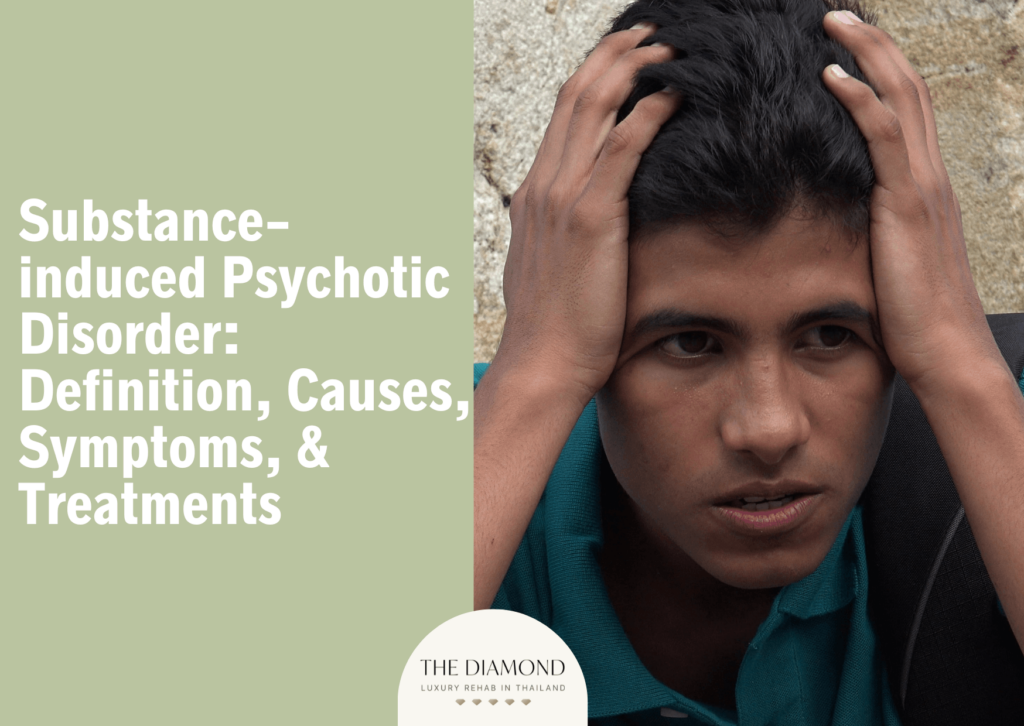
Substance-induced psychotic disorder is a type of psychotic disorder that people develop due to drug abuse or when withdrawing from substances. Alcohol triggers symptoms of psychosis as well. Unlike other psychotic disorders, this one is temporary, but it does make a person more susceptible to experiencing psychotic symptoms in the future.
The causes of substance-induced psychotic disorder are stroke or traumatic brain injury, personal history of schizophrenia, and genetic abnormalities.
The main symptoms of substance-induced psychotic disorder are hallucinations, delusions, and paranoia.
Types of substance-induced psychotic disorder revolve around substances abused and include alcohol, cocaine, cannabis, amphetamines, methamphetamine, club drugs such as MDMA and ecstasy, and psychedelic drugs such as LSD.
The treatment for substance-induced psychotic disorder includes medications and therapy. Medically-supervised detox is necessary for treating this disorder in people with addiction.
What is substance-induced psychotic disorder?
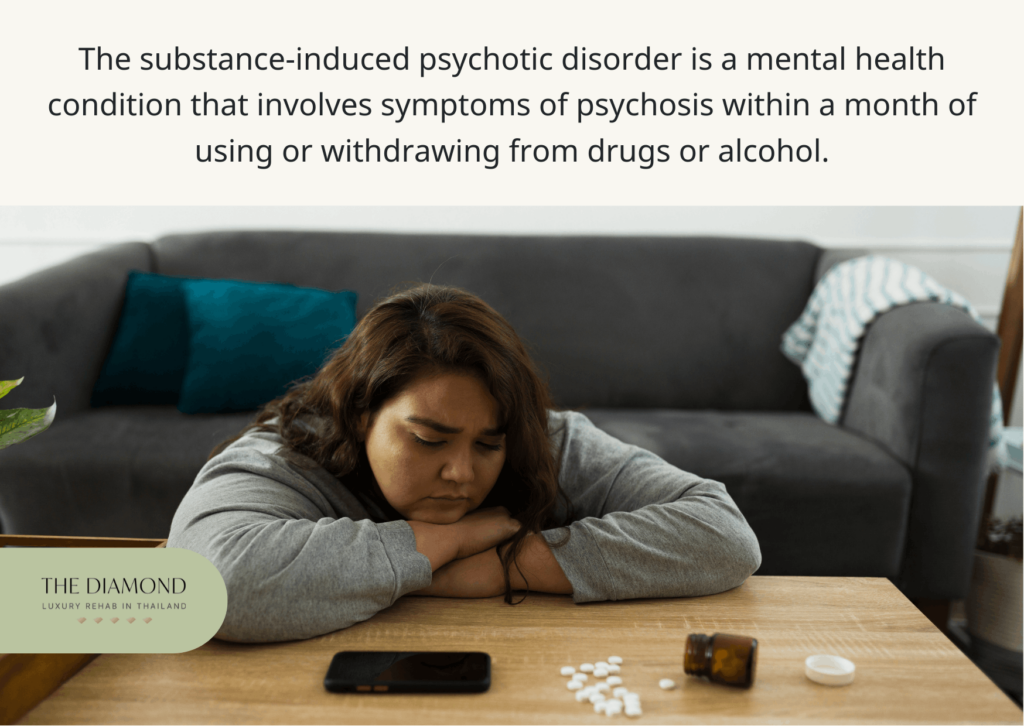
Substance-induced psychotic disorder is a mental health condition that involves symptoms of psychosis within a month of using or withdrawing from drugs or alcohol. Additionally known as toxic psychosis, drug-induced or alcohol-used psychosis, the condition occurs due to illicit and prescription drugs alike.
The condition is included in the American Psychiatric Association’s Diagnostic and Statistical Manual of Mental Disorders, Fifth Edition (DSM-5) in the chapter called Schizophrenia and Other Psychotic Disorders.
A publication titled, “Substance-Induced Psychosis in First Episode Programming” developed for Substance Abuse and Mental Health Services Administration’s Center for Mental Health Services stated that according to the DSM-V, 7% to 25% of individuals experiencing their first episode of psychosis have substance-induced psychotic illness caused by substance or medication use.
Drugs and substances associated with this psychotic disorder include amphetamines, cannabis, alcohol, cocaine, opioids, hallucinogens, phencyclidine (PCP), and sedatives or hypnotics. Excessive and chronic intake of alcohol additionally induce symptoms of psychosis.
According to a review by Fiorentini et al., published in the December 2021 issue of Frontiers in Psychiatry, illicit drugs possess psychotomimetic characteristics. Their use causes temporary psychotic symptoms as a result of acute intoxication.
Substance-induced psychosis involves multiple mechanisms such as higher levels of central dopamine, antagonist activity of NMDA receptors, and activation of receptors with the use of alcohol and drugs.
Information about the history of substance-induced psychotic disorder is scarce. What we do know is that the concept of psychosis stems from 1845 when the term was coined. However, even before that, since ancient times, physicians were interested in unique cases where people’s perception of reality was flawed or false.
Initially, the term psychosis was used as a synonym for mental illness until 1859 when German psychiatrist Carl Friedrich Flemming utilized the term to refer to mental disorders with identifiable organic findings and disorders of the soul which were believed to have an organic cause.
Several years later, in 1877, Flemming doubled down on his accentuation of psychotic pathology with organic roots. In the first half of the 20th century, psychiatrists and physicians gained more understanding of psychosis and discovered that psychotic symptoms aren’t products of a particular physical illness, rather a wide range of physical diseases that lead to psychic syndrome.
The concepts of psychosis and neurosis were in dichotomy until DSM-2 where it was explained that psychosis features severe functional impairment. The biggest distinction between the two came in DSM-4 which had a chapter Schizophrenia and Other Psychotic Disorders that included conditions where psychotic symptoms are dominant. That’s the same classification present in DSM-5 today.
How common is substance-induced psychotic disorder?
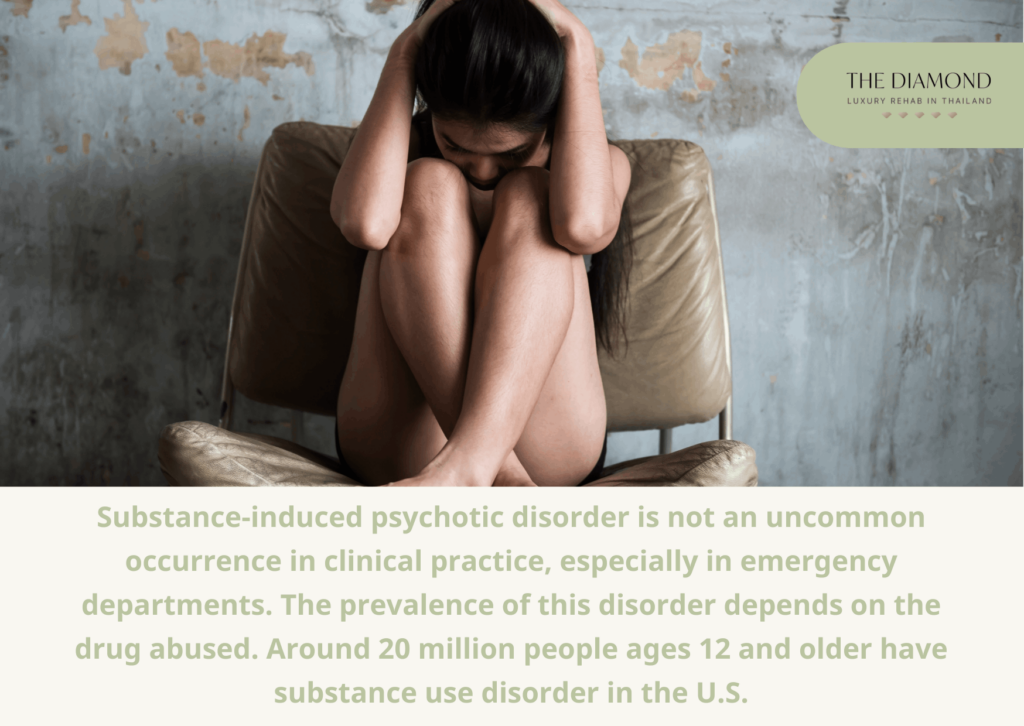
Substance-induced psychotic disorder is relatively common, with a prevalence of 36.5% in methamphetamine abusers, according to a 2018 meta-analysis by Lecomte et al., published in Psychiatry Research.
Its occurrence in clinical practice – especially in emergency departments – is widespread as well. In most cases, however, the prevalence of this disorder depends on the drug abused.
For instance, in 2009, the journal Comprehensive Psychiatry published a study by Smith et al., that examined the presence of psychotic symptoms in people with different types of substance abuse. The prevalence of psychosis in amphetamine abusers was 5.2% to 100%, between 12.4% and 80% for cannabis, 6.7% to 80.7% for cocaine, and 6.7% to 58.2% for opiates.
On the other hand, a 2021 review by Fiorentini et al., from the Frontiers in Psychiatry reported a psychosis prevalence of 18.8% for psilocybe mushrooms and 20.9% for LSD.
At this point, there is no information regarding the prevalence of the substance-induced psychotic disorder in children, teens, and the elderly. In a 2009 study by S. Aldandashi and M. Blackman published by the journal European Psychiatry, 70.37% of 27 adolescent participants exhibited symptoms of substance-induced mood disorder and 29.62% had substance-induced psychosis.
Although data about the prevalence of the disorder in men and women is lacking, scientists believe the difference is not that significant. A 2010 paper by Mahoney et al., from the journal Gender Medicine showed women were more likely to develop symptoms of psychosis, but more research is necessary.
What are the causes of substance-induced psychotic disorder?
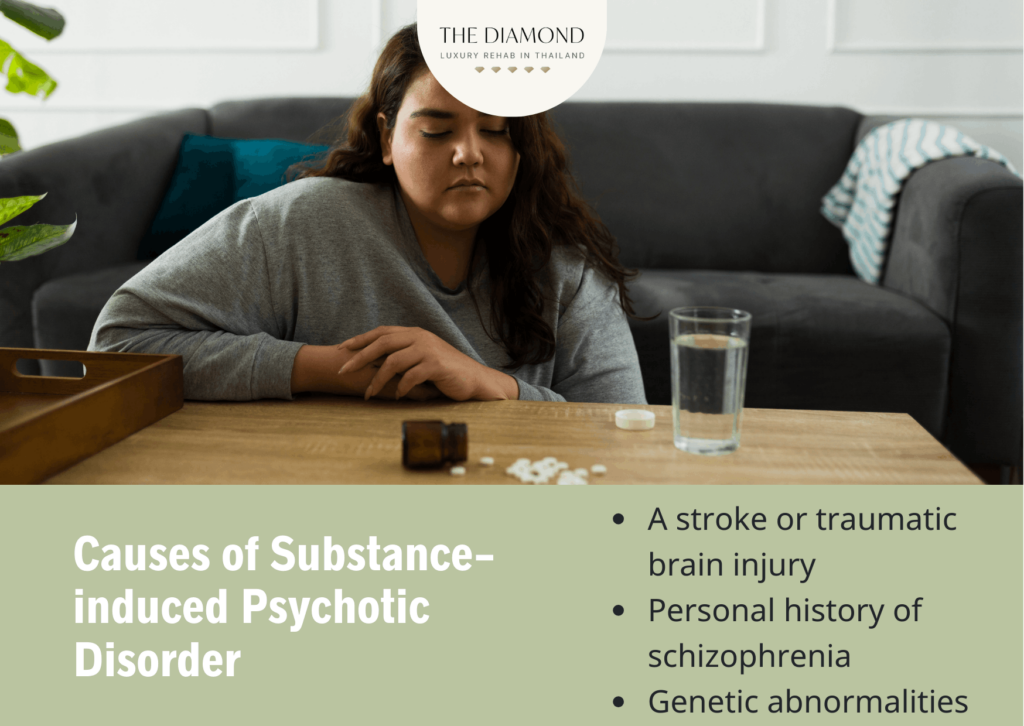
The causes of substance-induced psychotic disorders usually involve several factors that contribute to the development of the condition. The causes of substance-induced psychotic disorder are listed below.
- A stroke or traumatic brain injury
- Personal history of schizophrenia
- Genetic abnormalities
1. A stroke or traumatic brain injury
A stroke occurs when something blocks the blood supply to the part of the brain or due to a rupture of the blood vessel. In either case, parts of the brain become damaged or even die. On the other hand, traumatic brain injury (TBI) results from a violent blow or jolt to the head or body.
Both stroke and traumatic brain injury lead to symptoms of psychosis. A 2002 paper by Daryl Fujii and Iqbal Ahmed published in Cognitive Neuropsychiatry stated that following a delay of one to five years, pathophysiological processes triggered by traumatic brain injury typically lead to psychosis. Symptoms of psychosis after stroke or TBI usually include paranoid and persecutory delusions and hallucinations. The hallucinations are auditory in most cases.
It’s not entirely clear why stroke or TBI leads to psychosis, including substance-induced psychotic disorder. In certain cases, they act as stressors that interact with underlying genetic susceptibility. At the same time, both TBI and stroke produce structural or functional changes in sensory and other information-processing networks.
Stroke and traumatic brain injury make a person’s brain vulnerable and more prone to psychotic symptoms caused by substance abuse. This subject requires further research.
2. Personal history of schizophrenia
Schizophrenia is a psychotic disorder where people interpret reality abnormally. It is indicated by hallucinations, delusions, disorganized speech or thoughts, and negative symptoms such as loss of interest and social isolation.
A person with a history of schizophrenia is more likely to develop symptoms associated with a substance-induced psychotic disorder. Keep in mind schizophrenia is a lifelong condition; it’s impossible to eliminate it.
However, with medications and therapy, it’s possible to manage symptoms and improve quality of life. In other words, patients are able to manage their symptoms. Since they are still vulnerable to symptoms of psychosis, substance abuse tends to trigger the episodes again.
The relationship between substance abuse and schizophrenia is a two-way street. This means that drug abuse contributes to the development of schizophrenia and vice versa.
3. Genetic abnormalities
Genetic abnormalities are conditions resulting from changes to the genes or chromosomes. Mutations and variations to genes are passed to children from parents. This explains why symptoms of psychotic disorders tend to run in families.
Mutations of several genes increase a person’s vulnerability to psychosis. In fact, it is well-established that chromosomal abnormalities elevate the susceptibility to mood and psychotic disorders, as per a 2009 study by Craddock et al., published in Schizophrenia Bulletin.
While heredity is one of the causes of this disorder, it doesn’t act alone. Instead, a combination of genetics and other factors is likely the main reason someone develops the substance-induced psychotic disorder.
What are the symptoms of substance-induced psychotic disorder?
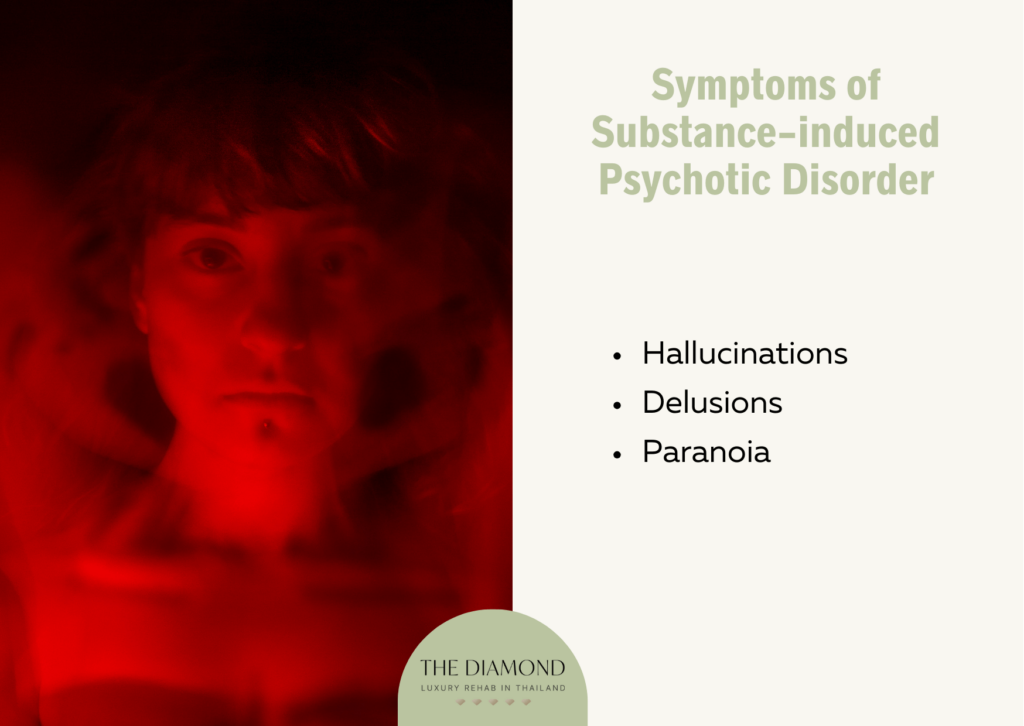
Symptoms of substance-induced psychotic disorder are comparable to positive symptoms of other psychotic disorders such as schizophrenia. The duration of symptoms depends on the type of the substance, but it’s generally under a month. The symptoms of the substance-induced psychotic disorder are listed below.
- Hallucinations
- Delusions
- Paranoia
1. Hallucinations
Hallucinations are defined as false perceptions of events or objects involving a person’s senses. They seem real, but they’re not. These false sensory experiences usually occur due to chemical reactions or abnormalities in the brain.
Hallucinations in substance-induced psychotic disorder involve one or several senses. All senses tend to be a subject of hallucination, but people usually have auditory (hearing) and visual hallucinations. In other words, they hear or see things that aren’t there.
Physical effects of hallucinations include problems with vision, lack of personal hygiene and self-care, weight gain, and problems associated with excess weight. On the other hand, behavioral effects of hallucinations include bizarre or odd behaviors, social isolation, anxiousness, and problems keeping up with work or school, which lead to frustration and irritability.
2. Delusions
Delusions are false beliefs that are persistent, fixed, and contradictory to reality. A person with delusions firmly believes in something despite the lack of evidence that is meant to confirm the idea they believe in. For example, an affected individual is convinced everyone wants to harm them even though it’s not true.
There are different types of delusions, including grandiose i.e., beliefs of being superior to others. In people with this disorder, drugs and alcohol act on the brain, which impair its functioning and cause delusions.
Physical effects of delusions include nausea, weight gain, a higher risk of diabetes, cancer, sexual dysfunctions, poor oral health, and respiratory-related concerns. When it comes to behavioral effects, delusions cause unusual attitudes and behaviors, anxiety, tension, social isolation, and angry attitudes toward friends, family, or coworkers.
3. Paranoia
Paranoia is defined as thinking or feeling of being threatened in a certain way, even when there’s no evidence for it. People with paranoia often believe someone wants to harm them or is out there to get them. Paranoid thoughts become delusions when they become so persistent that nothing convinces a person anymore that what they think isn’t true.
Physical effects of paranoia include lack of sleep and self-care, which leads to stress, messy appearance, and weight gain. Behavioral effects of paranoia include hypervigilance (constantly looking for threats), defensiveness, accusatory behavior, inability to take criticism, aggressiveness, and social isolation.
Who is affected by substance-induced psychotic disorder?
People who misuse drugs and alcohol are affected by substance-induced psychotic disorder. In addition, the disorder affects people who have suffered a traumatic brain injury or who have already been diagnosed with other mental illnesses such as bipolar disorder.
Persons with a family history of psychotic disorders are more likely to be affected by substance-induced psychotic disorders as well.
What are the risk factors for substance-induced psychotic disorder?
Risk factors for substance-induced psychotic disorder are different cases that make a person more susceptible to this mental illness. The risk factors for substance-induced psychotic disorder are listed below.
- Drinking excessive amounts of alcohol
- Drug abuse, especially polydrug use (taking multiple substances)
- Family history of schizophrenia and other psychotic disorders, mood disorders
- Alzheimer’s disease and other forms of dementia
- Personal history of mental illnesses
- Taking certain prescription medications such as methamphetamine prescribed for ADHD, opioids prescribed for pain relief, barbiturates that treat insomnia and seizures, and methylphenidate prescribed for the treatment of narcolepsy and ADHD
- Previous psychiatric hospitalization
- Non-drug related hallucinations
How is substance-induced psychotic disorder diagnosed?
Substance-induced psychotic disorder is diagnosed after a thorough evaluation. Based on the substance abuse and symptoms described, a psychiatrist suspects substance-induced psychotic disorder as the culprit.
To rule out other mental conditions, they are going to perform a psychiatric evaluation of symptoms, moods, behaviors, personal and family history, and severity of drug abuse. The psychiatrist is additionally going to interview family members to get a closer insight into the patient’s condition.
For an accurate diagnosis, the psychiatrist uses the DSM-5 diagnostic criteria. They diagnose substance-induced psychotic disorder if the symptoms begin within a month of using or withdrawing from drugs or alcohol and if a patient has had no psychosis-related symptoms before drug abuse.
Finally, people possibly need a physical exam and blood/urine and imaging tests such as MRI to rule out physical causes of their symptoms. In various cases, that isn’t necessary since psychosis in this disorder is associated with drug abuse.
How to prevent substance-induced psychotic disorder?
Preventing substance-induced psychotic disorder requires not taking drugs in the first place. By avoiding drugs (or excessive and chronic use of alcohol), a person doesn’t experience mind-altering effects, which trigger symptoms of psychosis.
Prioritizing self-care is important as well, especially in people who already misuse drugs and want to reduce the risk or frequency of psychotic symptoms. Self-care comes in several forms, such as mindfulness for stress reduction, breathing exercises, connecting with friends and family, and getting educated about the disorder.
What are the treatments for substance-induced psychotic disorder?

Treatments for substance-induced psychotic disorder depend on the specific needs of each patient, the type of substance used, the presence of underlying mental health problems, and the severity of symptoms. The treatments for the substance-induced psychotic disorder are listed below.
- Medications: A healthcare professional prescribes medications to decrease symptoms of the disorder and stabilize a patient’s mood. The medications include benzodiazepines, antipsychotics, and selective serotonin reuptake inhibitors (SSRIs).
- Medically-supervised detox: People with addiction to alcohol or other substances need a detox supervised by a medical team. During the detox process, they receive medications that reduce the intensity of withdrawal symptoms and psychosis. The best results occur when a patient follows a complete rehabilitation program, whether it’s inpatient or outpatient.
- Psychotherapy: This treatment is important for long-term benefits, especially in people with underlying mental health conditions. Various types of therapy are available, but the therapist chooses the one most suitable for the patient’s symptoms. Good examples are cognitive-behavioral therapy (DBT) and dialectical behavior therapy (DBT). The main role of CBT, as the most common approach, is to help patients identify negative thought patterns and replace them with more positive alternatives. During CBT sessions, patients learn to cope with their condition, improve skills necessary for daily functioning, and manage other mental health problems they potentially have. The exact number of sessions varies from one patient to another, but it ranges from 6 to 20 for most people.
Do substance-induced psychotic disorders have a cure?
Yes, substance-induced psychotic disorders have a cure, and that is to stop abusing any drug or alcohol. The reason is simple, alcohol or drug abuse is the main trigger for symptoms of psychosis in these cases. So, ceasing substance abuse allows a person to eliminate the main trigger behind their symptoms.
However, doing so is easier said than done in practice. Addiction is a complicated disease, and it’s not that easy for a person to simply stop using a certain substance. When psychosis occurs during withdrawal, it is difficult for someone to handle.
In fact, withdrawal symptoms are a major reason why numerous people continue using drugs. However, with a well-structured treatment program, medical supervision, and support, it’s possible to overcome withdrawal and start the recovery process.


